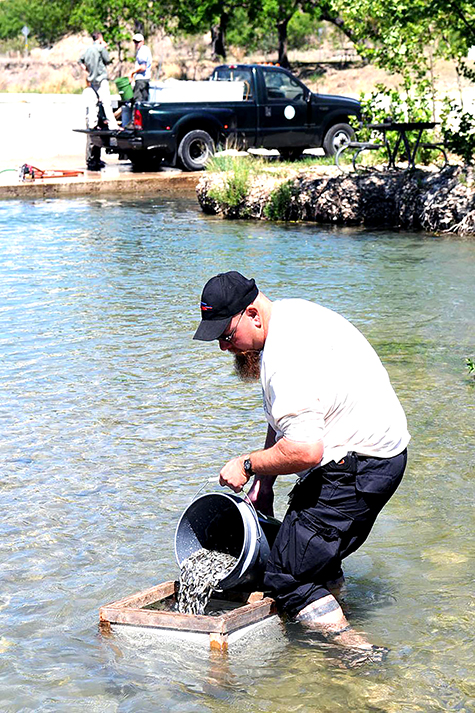
A TPWD Inland Fisheries employee releasing Guadalupe bass fingerlings into the South Llano River. When Inland Fisheries staff discovered the State Fish was becoming hybridized with smallmouth bass, they ceased stocking smallmouth bass in several Hill Country rivers to maintain the pure strain. Guadalupe fingerlings are raised at TPWD’s email Heart of the Hills Hatchery. (Texas Paks and Wildlife Department Photo)
Guadalupe Bass (Micropterus treculii)
by John Jefferson
Ever wonder why fishing is so good in Texas?
Or are you one who has trouble catching anything besides an old boot, a tree root, or an inconsiderately discarded plastic water bottle or beverage can? Sounds like some of my catches!
But it doesn’t have to be like that. Texas Parks and Wildlife Dept. (TPWD) offers introductory fishing courses. That unravels the mysteries of fishing. Most experienced anglers could also help get you started. For information about TPWD’s angler information courses, google https://tpwd.texas.gov/education/angler-education.
But then after you’ve received valuable fishing lessons, get out on a nearby waterbody and begin applying what you’ve learned. But how do you know there are any fish in that water?
I can almost guarantee that any lake, stream, or pond in Texas has fish. I say that with confidence since Texas has one of the nation’s premier fish stocking programs for both freshwater and saltwater fish. A mid-March press release from TPWD spoke of the twenty-seven million freshwater fish TPWD’s Inland Fisheries crew stocked last year! And 3.1 million anglers can’t be wrong!
That’s how many anglers bought Texas freshwater fishing licenses in 2022! (Kids under age 17 aren’t required to have a license.) Those guys, and gals fished in Texas’ 1,100 public reservoirs, and 191,000 streams, creeks, and rivers! And that doesn’t include private farm and ranch ponds.
And at least 28,994 anglers from other states or countries bought non-resident fishing licenses! That figure would be higher if you could factor in the non-native inland fishing-purchasers of combination hunting and fishing licenses. Even without guessing at how many out-of-stater combo license buyers were inland anglers, nearly 29,000 known non-resident license buyers making the trek to Texas to fish speaks volumes for the fishing opportunities offered to non-Texans!
So, what does TPWD offer to all who want to fish here?
Well, for one thing, it’s not just all for bass anglers in big, expensive bass boats! Those boys and girls benefit from TPWD’s fish stocking, too — but not to the exclusion of others. The Inland Fisheries staff creates new fishing opportunities and re-establishes waters troubled by Nature or humans. They also supplement sagging populations and boost genetic makeup where needed. And all that boosts Texas’ economy.
Between the revenue produced by top largemouth bass producing lakes ($10-$37 million), striped bass ($47 million), Guadalupe bass, white bass, rainbow trout, Rio Grande cichlids, and sunfish ($74 million), restocking is justified.
Seventeen species or sub-species of fish were stocked in 2024, including three catfish sub- species, five largemouth bass sub-species, smallmouth bass, white bass, rainbow trout, red drum, bluegills, and even walleyes! That totals 26,268,973 fingerlings and larger fish!
When I began fishing, Texas had one hatchery – Heart of the Hills near Mountain Home. A rising human population required more fish. We now have five more hatcheries.
It’s no wonder people travel distances to fish in Texas! You can catch more fish, bigger fish, and more species, than anywhere between Canada and the Rio Grande!
Give it a try!
JJ




